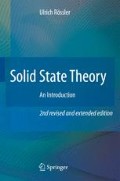Abstract
The electron spin, which does not explicitly appear in the N-particle Hamiltonian of the solid (except for the spin-orbit coupling and Zeeman terms), will be in the focus of this chapter. In Chaps. 4 and 5 we have addressed already the relevance of spin in connection with magnetic properties, which shall be studied now in more detail. The issue here will be to consider the interacting electron system with dominating exchange interaction, which leads to a spin-ordered ground state, and to describe elementary excitations out of this ground state: spin waves or (in quantized form) magnons. In several aspects, spin dynamics is similar to lattice dynamics (see Chap. 3) with the masses coupled by springs, now being replaced with spins (or their magnetic moments) coupled with exchange interaction. Depending on the complexity of the crystal structures on which these spin systems are realized, their spin or magnetic order can be ferromagnetic, anti-ferromagnetic, ferrimagnetic, or anti-ferrimagnetic [163]. Most standard textbooks on Solid State Theory contain a chapter on spin waves or magnons and magnetic properties, but there are also special review articles [164, 165] and monographs [116, 166–172] on these topics. In solids with disorder, e.g. due to alloying, the magnetic order takes the form of spin glasses [16]. Theoretical concepts developed for spin glasses have turned out to be useful also for neural networks [173]. A variant of magnetic order in disordered solids are diluted magnetic semiconductors of which A3B5 with Mn ions randomly replacing the A3 atoms show ferromagnetic order (see [174–176]). The latter materials have gained much interest in connection with spintronics [177, 178], a concept of electronics using the electron spin rather than its charge. Magnetic order exists as a ground state property only, below some critical temperature at which a phase transition takes place. It can be described using the molecular or mean field approximation. For spin excitations at the surface of magnetic solids (surface magnons) we refer to [179, 180].
Access this chapter
Tax calculation will be finalised at checkout
Purchases are for personal use only
Preview
Unable to display preview. Download preview PDF.
Author information
Authors and Affiliations
Rights and permissions
Copyright information
© 2009 Springer-Verlag Berlin Heidelberg
About this chapter
Cite this chapter
Rössler, U. (2009). Spin Waves: Magnons. In: Solid State Theory., vol Rössler. Springer, Berlin, Heidelberg. https://doi.org/10.1007/978-3-540-92762-4_6
Download citation
DOI: https://doi.org/10.1007/978-3-540-92762-4_6
Published:
Publisher Name: Springer, Berlin, Heidelberg
Print ISBN: 978-3-540-93785-2
Online ISBN: 978-3-540-92762-4
eBook Packages: Physics and AstronomyPhysics and Astronomy (R0)

